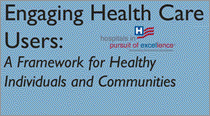AHA/HRET Guides
Engaging Health Care Users: A Framework for Healthy Individuals and Communities

The AHA’s framework for health reform, Health for Life, embraces the need to engage patients and families and contemplates the role of hospitals and health care systems in improving the overall health of the population and communities they are serving. Within this context, in 2012 the AHA Board Committee on Research focused on actively engaging health care users to improve outcomes and reduce health care costs.
The committee developed this report, "Engaging Health Care Users: A Framework for Healthy Individuals and Communities," advocating hospitals to become more “activist” in their orientation and move “upstream”—that is, to do more to engage patients and intervene earlier in the disease states. Because achieving Health for Life requires action from key players within the health care system to create a culture that supports health care user engagement, this report introduces a continuum for engagement from information sharing to partnerships. It recommends entry points for user engagement occurring at four different levels of the health care system.
- Individual: The aim is to increase the skills, knowledge and understanding of patients and families about what to expect when receiving care.
- Health Care Team: The focus is to promote shared understanding of expectations among patients and providers when seeking care.
- Organization: The objective is to encourage partnerships and integrate the patient and family perspective into all aspects of hospital operations.
- Community: The emphasis is to expand the focus beyond the hospital setting and find opportunities to improve overall community health.
The remaining sections of the report include case studies highlighting strategies that hospitals and health care systems have already deployed to engage health care users as active participants in their care. In addition, topic areas that are likely to have significance in the future of health care user engagement are addressed including:
- Consideration and integration of behavioral health and mental health as they relate to engagement at all four levels
- Role of health plans as significant stakeholders in the engagement process
- Role of employers as drivers for creating a culture of health
- Emergence of new technologies that will facilitate patient, family and provider interactions; health education; treatments and overall engagement
- Role of social media as a means to enhance communication and networking with individuals and communities
Additional Resources
Equity of Care Webinar SeriesPart 2: Aligning Diversity and Inclusion, Community Engagement, Busi......
VIEW THIS RESOURCEEquity of Care Webinar SeriesPart 1: Aligning Diversity and Inclusion, Community Engagement, Busi......
VIEW THIS RESOURCETransportation and the Role of Hospitals This AHA webinar on “Transportation and the Role of Hos......
VIEW THIS RESOURCE

